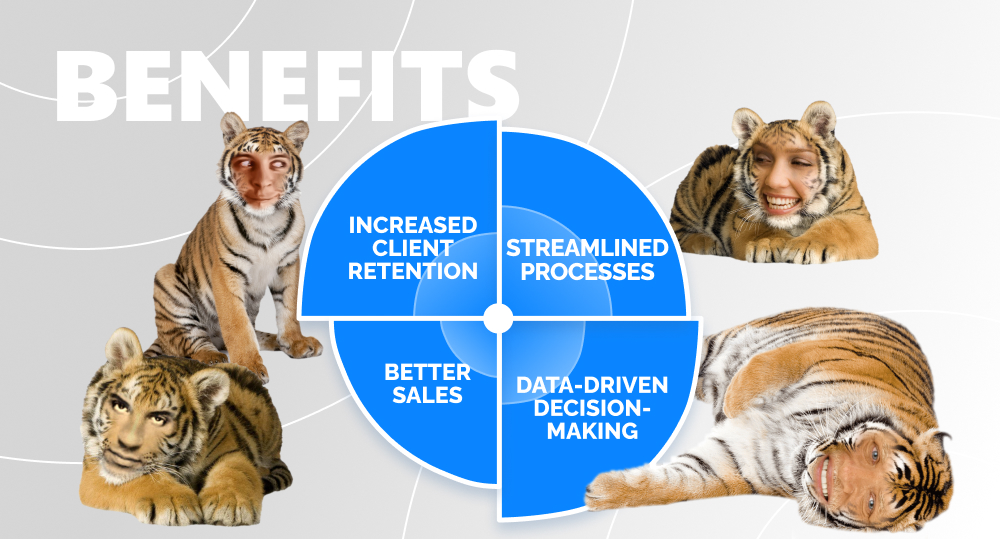Big data analytics in banking is everything. This industry is built on the idea that today you should be making decisions wiser than yesterday’s, so it doesn’t say no to the opportunity for amelioration. Mordor Intelligence writes that the banking market size is expected to grow from $6.97 million in 2023 to $19.72 million around 2028, at a CAGR of 23.11%. And while the sector is generally perceived as one that is notoriously resistant to change, adopting technology at that speed to revolutionize the way it operates is groundbreaking for such a prodigious industry.
In this article, we will reconnoiter the banking sector and talk about companies that have successfully adopted big data analytics to crack open their big bright futures.
written by:
Anton Rykov
Product Manager
Contents
A Brief Introduction to Big Data
To succinctly lay out the essence of big data, let's turn to Investopedia, “Big data refers to the large, diverse sets of information that grow at ever-increasing rates. It encompasses the volume of information, the velocity, or speed at which it is created and collected, and the variety, or scope of the data points being covered.”
Big data in banking comes from many places: personal and transactional information, credit card history, apps, surveys, web and social media interactions that are publicly shared, and so on. Every bit that reflects customer engagement within the financial services industry falls into one of the three categories:
- Structured data (e.g., transactions and financial records);
- Unstructured data (text, multimedia files, etc.);
- Semistructured data (like web server logs).
Ah, yes: if you've ever heard of the three V's, a.k.a. three pillars of big data, they are volume, velocity, and variety from the above definition. Over time, progressively (and aggressively) more V's have been added to the list (this source suggests there are now 56 of them!), but still, it's veracity and value that stand out on that alphabetic scene of newcomers. Veracity refers to the quality and accuracy of big data, while value reflects how useful it would be in the process of decision-making.
If you examine big data with all of its V's through a magnifying glass of analytics, what advantages can you unfold?
How Can Big Data Analytics in Banking Benefit Your Financial Institution?
- Better sales. For a good while, the banking and finance industry provided one-size-fits-all solutions. But that era is gone: it is clear now how customer profiles, their needs, and opportunities differ, and banking institutions have to acknowledge that to generate revenue. Harnessing the power of machine learning and artificial intelligence, you can conduct a customer segmentation analysis to track customer behavior throughout your platforms and create targeted marketing campaigns to deliver the dream product to the client. It's strictly business, but these days, it has to get personal.
- Increased client retention. Banking financial institutions collect massive quantities of customer data, which is a true eye-opener when it comes to customer preferences (if you, of course, ensure data accuracy, relevancy, and quality). That brings forth every chance to enhance customer service, thus increasing customer satisfaction rates. A happy client is the client that returns to you ready to build a long-lasting relationship.
- Streamlined processes. Big data analysis lets financial organizations examine every detail of every process that makes up their workflow. Thanks to such advanced analytics techniques, it's easy to deduce which areas require prioritization and immediate attention, and get rid of redundancy. Since employee performance gets a boost (with data becoming transparent and cluster-free, the job is done easier and faster) and operating costs go down, operational efficiency turns into a constant.
- Data-driven decision-making. Whether we're talking about the next marketing campaign for your financial institution or security and risk management processes, big data implementation has your back. With its help, organizations within the banking industry can rely not only on experience, expertise, and hunches, but also on facts, metrics, and patterns, ensuring that decisions are strategic, relevant, and align with their business objectives.
Big Data Analytics in the Banking Industry: Use Cases
Big data is gathered across many sources. Equally, the results of its analysis can be applied in a myriad of scenarios. This means that the list of big data use cases is infinite, hence the market is booming with enticing propositions like data visualization and preparation, predictive modeling, fraud detection, reporting, and so on. Major players such as IBM, Oracle, SAP, Accenture PLC, Alteryx, Salesforce, and BigPanda offer their services to financial institutions worldwide, inviting them to make a banking analytics oriented shift.
For this article, we've handpicked a couple of banking industry participants and use cases that will help us prove: it's a good idea to give the new a chance.
* If you are willing to accommodate big data analytics, let us know. We have 20+ years of experience in the banking sector and an immense desire to support financial institutions in the era of digital transformation.
#1. Personalized Banking Solutions
In 2022, J. D. Power conducted the U. S. Retail Banking Satisfaction Study which surveyed over 101,000 people. The study found that 78% of respondents would continue using their bank if they received personalized support, however, only 44% of banks are actually delivering it.
Take a look at the list of banks with personalization solutions they have implemented:
- Oversea-Chinese Banking Corporation (OCBC). The financial institution approached the task in dead earnest: to implement an event-based marketing strategy, they went through historical customer data and identified individual customer preferences. That allowed the corporation to establish personalized marketing communications with their clientele across e-mails, call centers, text messages, etc. That is a whole new level of using big data analytics in the retail banking!
- American Express. This company does something that traditional financial institutions could never even dream of: prediction of customer behavior through the analysis of historical transactions and incorporation of more than 100 variables. This lets the company keep their finger on the pulse of customer loyalty and take precautions in the case of a churn. Apart from predictive modeling, AmEx is praised for their social media marketing. AmEx credit card owners can connect their products to personal social media accounts, i.e., the bank gets access to their online activity. This gives American Express the opportunity to offer discounts to each user (e.g., from a specific brand that the user follows) tailored to their preferences.
- Capital One. This financial corporation is all about increasing customer loyalty, and machine learning alongside artificial intelligence are their loyal companions on this journey. Firstly, they analyze customer segments and spending patterns to determine the best time to approach clients with a new offer. Secondly, they educate their audience about products. The corporation presents each customer with a set of personalized instructions based on their behavior: those who need to activate cards or set up digital servicing accounts receive messages of encouragement, while clients that start spending right away learn more about maximizing rewards and unleashing the card's full potential. In an interview to Fast Company, the brand representative commented, “Over time, these consumers are more engaged, more loyal, and better understand the benefits of the card. Overall, that increases that customer’s lifetime value.”
We would also like to briefly mention virtual assistants. Those are irreplaceable when you need to make customer experiences personal and resolve inquires without investing human or financial resources. To give you a few examples, we have Chase Digital Assistant from Chase Bank which can help you check your account balance, view investments, pay bills, or transfer money, and Capital One’s virtual assistant Eno which can perform tasks like monitoring customer spending patterns. Consequently, Eno is capable of identifying fraudulent behavior in your bank account and sending alerts.
#2. Cybersecurity and Fraud Detection
In the banking industry, dangers never rest, they're always lurking and waiting for the best time to attack a business and steal its data, customers, money, and ruin its reputation. Take a look at this: Cybercrime Magazine reports that, “Global cybercrime damage is predicted to hit $10.5 trillion annually by 2025.” Back in 2015, we were looking at $3 trillion, and now this threat costs so much money that if cybercrime were a country, its economy would be the world’s third-largest one after the U. S. and China.
Another horrifying example: identity fraud. According to Insider Intelligence, “31% of banks said the incidents cost them on average $479,000 or more. The costs stemmed from business disruptions (44%), penalties and fines (36%), and legal expenses (36%). Every dollar a bank loses in a fraud incident costs that bank four times that amount.”
How can big data analytics prevent security breaches and protect your data privacy?
- American Express, Visa, Chase Bank. These guys prove that real-time big data processing is what truly changes the game for participants in the industry. All of these banks utilize the same approach: they look into vast quantities of transactions on a minute-by-minute basis to instantly spot anomalies and react if necessary. AmEx specifically collects information from both merchants and customers to identify spending trends and define whether a purchase is legitimate.
- Zions Bancorporation. The Utah-based bank leverages big data analytics to detect cross-channel anomalies that can uncover fraud. In an interview on big data, bank representatives said that predicting the data you're going to need in the future is hard, so removing the parts of it that are not relevant to the problem you're dealing with right now is not the best strategy. Hence, at Zions, they decided to unite all data. “When incidents occur, we don't have to track down the data to be able to analyze it. We're able to have that at our fingertips ready to go to get answers to those questions, and the data repository also acts as a large source for testing models as we develop them.”
- JPMorgan Chase & Co. This financial organization definitely makes the most of big data analytics in the banking market. To prevent internal fraud, the company applies software developed by Palantir to track employee communications, which includes their staff's browser history, e-mails, and call history. For external fraud detection, JPMorgan Chase & Co. uses Apache Hadoop. A company representative explains, “Hadoop's ability to store vast volumes of unstructured [customer] data allows the company to collect and store web logs, transaction data and social media data […] that we never stored before. The data is aggregated into a common platform for use in a range of customer-focused data mining and data analytics tools”.
*By the way, we have a vast expertise in business intelligence and analytics. Let us know if you would like to learn more about our projects! We will gladly send you a case study of big data analytics in the banking sector (or a few!).
#3. Lending Decisions
Banks and other financial institutions have been using big data to analyze a client's ability to pay the loan back for a long time. But the number of characteristics that impact their lending decisions, as well as the volume of customer data that might be useful for assessment, continuously grows:
- Kreditech. The German online lender took a creative approach to make up their mind about potential clients. To analyze big data, they apply a self-learning algorithm that calculates a person's credit score at lightning-bolt speed using up to 20,000 data points. For example, research found that an individual who makes spelling mistakes in a loan application is less likely to make timely payments, so the German lender checks how accurately the document is filled. Kreditech also pays attention to the frequency of parcels received (regular online shopping indicates a steady income), social networking data (posts, likes, friends, and locations) and other aspects of online behavior to determine creditworthiness of an individual.
- Lendit. A Korean P2P lending service. To make lending decisions, the company puts to good use not only behavioral patterns of a potential client when they search the Lendit website, but also their Facebook information. Such a thorough exploration of the applicant's actions and background is easy to explain: the company believes that everyone should receive a personalized interest rate that directly correlates with their credit. With Lendit, a person who recently got a new job and doesn't make much money now but comes from a family of a stable income can still receive a loan on favorable terms.
- KEB Hana Bank. This Korean bank has been using big data for some time now. Among other things, they craft visualized reports based on reputation data, and create recommendations for new loans based on the analysis of a customer lifestyle.
- JPMorgan Chase & Co. And here they are again! The banking industry giant leverages a machine learning algorithm powered by the company’s private cloud network to reduce the time for documents review. For loan servicing, where applications pile up at the speed of light, efficiency is crucial. The results are astonishing: in the past, it took about 360,000 hours to complete the task, and now it's a matter of seconds. A pleasant bonus: automation of this monotonous but extremely high-stake task significantly reduces human error.
Challenges of Big Data in Banking
Despite big data being generally a good thing for the financial service industry, it still spices up the realm of personalized customer service, outstanding data quality management, and business process optimization with its strenuous challenges.
Lack of resources
Building a manageable big data architecture is very expensive, time-consuming, and requires assistance of experienced programmers. Often banks can’t spare such resources for modernization.
Legacy systems are still around
43% of US banks still use COBOL, a programming language invented in 1959. This overcomplicates the already troublesome task of inviting big data practices to financial institutions.
Big data is too big
Most organizations are incapable of handling the volume of work that big data calls for, considering how much of it there is worldwide and the current state of the industry.
Security and privacy
Financial institutions store a lot of personal information. The risk of its misuse and its utter sensitivity demand appropriate security measures. Many companies fail to provide them and suffer from cyberattacks with brutal consequences.
Regulatory compliance
Data privacy laws and regulations like GDPR, HIPAA, and others differ depending on the region and constantly fluctuate. This makes keeping up with the ever-evolving regulatory landscape hard and increases the risk of non-compliance, which entails severe reputational and financial losses.
Coming Up with a Big Plan
If you want to keep your business up and running, retain customers, win over the hearts of newcomers, and make informed decisions about your business growth, you have to give big data analytics a chance. But you know how the saying goes: nothing ventured, nothing gained. While big data analytics is ready to bestow great gifts on those who are determined to make it work, it is a risky business. Our advice? Consider a partnership with a big data software company that can guide you on this journey forward.
What is there left to say? Our company is excellent at handling big tasks, so if you’re in need of expert big data consulting, feel free to reach out to us. We're one filled form away!

Contacts
Feel free to get in touch with us! Use this contact form for an ASAP response.
Call us at +44 151 528 8015
E-mail us at request@qulix.com










